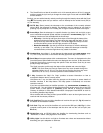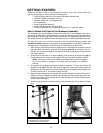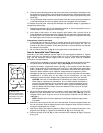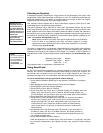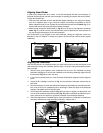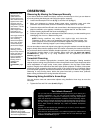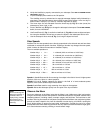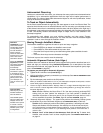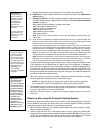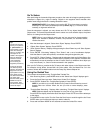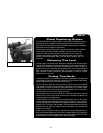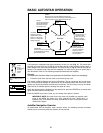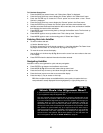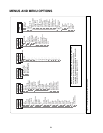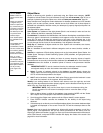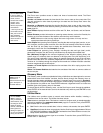
19
A
utoStar also determines the positioning (
i.e
.,
tilt and tip) of the optical tube
.
b.
Finds North.
Locates magnetic Nor
th, then calculates true North. See
FINDING TRUE
NORTH,
page 21.
c. Attempts a "GPS Fix." The GPS receiver attempts to acquire and sync up with signals
from GPS satellite system. "Getting GPS Fix" displays. See
THE GLOBAL POSITIONING
SYSTEM
on page 21.
After performing these operations, AutoStar now knows:
ܖ The telescope's limiting positions
ܖ Where level is for the telescope
ܖ The location of tr
ue North
ܖ The observing site's location
ܖ The date and time
Note: Press any key to abort the GPS fix.You will then be prompted to enter the time, date
and location.
d. Once the level, tilt and North are detected, the telescope will “Go To” 2 alignment stars.The
telescope will go to these stars in order to orient itself to the sky.Once it has done this, it will
be able to point to any of the more than 30,000 stars in its database.
“Automatic Alignment: Selecting Star” and “Slewing” display. Finally, when it is close to the
alignment star “Center Brightest Star: Press ENTER” displays. Use the Arrow keys to center
the alignment star in the eyepiece. The alignment star will be the brightest star in that area
of the sky (and hence, “brightest star”). When the alignment star is entered, press ENTER.
Note: If you press the “?” key while “Ctr Brightest Star” displays, the alignment star that
AutoStar has chosen will display. For example, “Arcturus: Press ENTER” may display.
Note: If you have an obstruction, such as a tree or a building blocking your view of the align-
ment star, or if you have any doubts at all about the star that has been chosen, no problem.
Just press the Scroll Down key and AutoStar will find another star to align upon.
However, when the telescope slews to the first star, it may not appear in the field of view
in the eyepiece. Use the SmartFinder (
17, Fig. 1) and /or the viewfinder (1, Fig. 20) to
locate the star.The alignment star will be easy to recognize—it will be the brightest star in
the area of the sky where the telescope is pointing. Look through the SmartFinder or the
viewfinder and use the Arrow keys to move the telescope until the star is visible.Then look
through the eyepiece and center the star using the Arrow keys. Press ENTER. Repeat the
procedure for the second alignment star.
When the procedure is performed correctly, "Alignment Successful" displays. If AutoStar
does not display this message, perform this procedure again.
NOTE: The alignment stars may change from night to night. All that is required is
for the observer to center the selected stars in the eyepiece when prompted.
6. The telescope now slews to the second alignment star.AutoStar displays “Center Brightest Star:
Press ENTER” displays. Use the Arrow keys to center the alignment star in the eyepiece.When
the second alignment star is centered, press ENTER.“
7.
“Alignment successful”
displa
ys
.
If
“Alignment Unsuccessful” displays, perform the procedure
o
ver again.
Observe a Star using the Automatic Tracking Feature
Now that your telescope has been aligned, you are able to track celestial objects. In this exam-
ple, the AutoStar Arrow keys are used to find a star, and then AutoStar's tracking capability
automatically k
eeps the star centered in your telescope's eyepiece.
1. When Automatic Alignment is completed (as described in the previous section), "Select:
Object" displays on AutoStar II.
2. Select a bright star from one of the Object menus. You may choose any unobstructed,
bright star for the purposes of this example. Use the viewfinder (
22, Fig. 1) to help line up
on the star. Use AutoStar's Arrow keys to center the star in the eyepiece. The tracking
motors will then keep the star you have chosen in the center of the eyepiece.
IMPORTANT NOTE:
While performing the
automatic tracking,
only use the Arrow
keys to move the tele-
scope. Once the tele-
scope has been set in
the Alt/Az home posi-
tion, do not loosen the
telescope locks (
6
and 9, Fig. 1
), or
move the base
manually, or alignment
will be lost.
Impor
tant Tip:
It is recommended
that you train your
telescope’s drive the
first time you align
your telescope.
Training the drive
improves your
telescope’s pointing
precision.
For more information
about pointing your
telescope, see page
56 for more
information.
IMPORTANT NOTE:
The "Telescope: Mount"
option of the Setup
menu is set to "Alt/Az" as
the default alignment by
the factory.The example
presented in this section
assumes that you are
performing an alignment
procedure for the first
time with your telescope
and theref
ore
, the
"Telescope: Mount"
option does not need to
be selected.
For
information on equatorial
(P
olar) alignment, see
APPENDIX A,”page 50.



